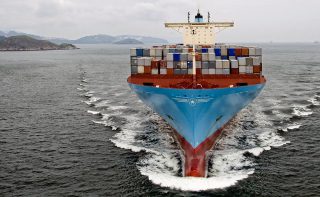Drewry: New Tonnage the Biggest Risk for Industry Recovery

One of the key performance indicators that needs to be ticked off before the containership industry recovery gets back on solid ground is when the industry does not have to squeeze ships into trades that are not equipped to handle them.
“We are more optimistic than we have been in a long while as demand will continue to make small, incremental gains and freight rates will rebound after last year’s nadir. However, we also identified the biggest risk to that outlook as the huge number of ship deliveries, particularly at the top end of the scale,” Drewry informed.
This year the industry will have to make room for as much as 1.7 million TEU of newbuilds, if none slip into next year, with over half being 14,000 TEU or above.
Topper most of the recipients will be the world’s three largest carriers, the Danish giant Maersk, Swiss Mediterranean Shipping Company (MSC) and French CMA CGM, which suggests they will further extend their lead over their peers in the top 5.
Drewry said that because most of the big ships will go straight into the Asia-North Europe market they will push out smaller units into secondary routes such as Asia-Mediterranean, Transpacific and the Asia to Mid-East routes. Then the cascade continues as ships in those routes have to find a new home or potentially be laid up.
Average ship sizes have increased faster than demand on most of the East-West trades with the exception of the westbound Transatlantic. A 22% jump in the size of vessels serving Asia to East Coast North America is entirely linked with the widening of the Panama Canal last summer but the disparity with demand growth does mean that carriers have had to make a trade off by reducing the number of services.
Additionally, the North-South trades have almost universally suffered from weak demand on headhaul legs and are not in a position to absorb too much additional capacity.
“These trades are the victims of the fact there is simply nowhere else to put the cascaded East-West ships and until they recover the demand strength carriers will either have to accept poor returns on freight rates or park more ships,” Drewry said.
HEADLINES
- Do shipping markets want Biden or Trump for the win?
- All 18 crew safe after fire on Japanese-owned tanker off Singapore
- Singapore launching $44m co-investment initiative for maritime tech start-ups
- Cosco debuts Global Shipping Industry Chain Cooperation Initiative
- US warns of more shipping sanctions
- China continues seaport consolidation as Dalian offer goes unconditional